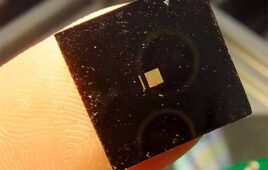
A tiny participant in the Northwestern University study of a wireless NICU monitoring system. (Image courtesy of Science, per a Creative Commons 4.0 license)
A new, less invasive system for monitoring preterm and critically ill newborns’ vital signs would allow parents skin-to-skin contact with their babies when they otherwise couldn’t have it.
The system, designed by researchers at Northwestern University in Chicago, uses ultrathin, skin-like electronic sensing technology to overcome the limitations of traditional systems that require a large number of wired sensors. The researchers developed a pair of sensors that only require water to adhere to a newborn’s fragile skin and allow for untethered monitoring of key vital signs and can streaming data wirelessly it in real time to external devices.
Four essential advances in engineering science conributed to smaller, lightweight systems that are less traumatic to the skin, than existing alternatives, according to an article in the journal Science. They are:
- Schemes for wireless power transfer, low-noise sensing, and high-speed data communications via a single radio-frequency link with negligible absorption in biological tissues.
- Efficient algorithms for real-time data analytics, signal processing, and dynamic baseline modulation implemented on the sensor platforms themselves.
- Strategies for time-synchronized streaming of wireless data from two separate devices.
- Designs that enable visual inspection of the skin interface while also allowing magnetic resonance imaging and x-ray imaging of the baby.
The infant would wear two devices, one on the chest to capture electrocardiograms (ECGs) and the other on the base of the foot to simultaneously record photoplethysmograms (PPGs). Together, the sensors yield measurements of heart rate, heart rate variability, respiration rate, blood oxygenation, and pulse arrival time as a surrogate of systolic blood pressure, according to the study. Each device also transmits skin temperature data. The researchers reported successful tests on neonates with gestational ages ranging from 28 weeks to full term, demonstrate the full range of functions in two level-III NICUs.
In an accompanying article, Ruth Guinsburg of Division of Neonatal Medicine, Escola Paulista de Medicina–Universidade Federal de São Paulo in Brazil described the researchers’ work as “part of a frontier in which physics, chemistry, and engineering bring new options to clinical care… This technology may improve the care of very preterm infants in developed-world settings, but also has great potential impact on monitoring practices all over the world and may give many neonates a more equitable opportunity to survive.”




